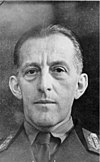The Condor Legion was a unit composed of military personnel from the air force and army of Nazi Germany, which served with the Nationalists during the Spanish Civil War of July 1936 to March 1939. The Condor Legion developed methods of strategic bombing which were used widely in the Second World War shortly afterwards. The bombing of Guernica was the most infamous operation carried out by the Condor Legion. Hugo Sperrle commanded the unit's aircraft formations and Wilhelm Ritter von Thoma commanded the ground element.
The Battle of the Ebro was the longest and largest battle of the Spanish Civil War. It took place between July and November 1938, with fighting mainly concentrated in two areas on the lower course of the Ebro River, the Terra Alta comarca of Catalonia, and the Auts area close to Fayón (Faió) in the lower Matarranya, Eastern Lower Aragon. These sparsely populated areas saw the largest array of armies in the war. The battle was disastrous for the Second Spanish Republic, with tens of thousands left dead or wounded and little effect on the advance of the Nationalists.

Werner Mölders was a World War II German Luftwaffe pilot, wing commander, and the leading German fighter ace in the Spanish Civil War. He became the first pilot in aviation history to claim 100 aerial victories—that is, 100 aerial combat encounters resulting in the destruction of the enemy aircraft—and was highly decorated for his achievements. Mölders was instrumental in the development of new fighter tactics that led to the finger-four formation. He died in an air crash in which he was a passenger.

The Spanish Cross was an award of Nazi Germany given to German troops who participated in the Spanish Civil War, fighting for nationalist general, later Spanish caudillo, Francisco Franco.

The Battle of Brunete, fought 24 kilometres (15 mi) west of Madrid, was a Republican attempt to alleviate the pressure exerted by the Nationalists on the capitol and on the north during the Spanish Civil War. Although initially successful, the Republicans were forced to retreat from Brunete and suffered devastating casualties from the battle.
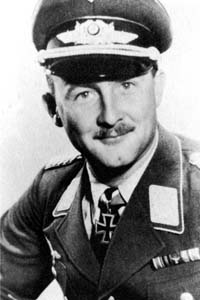
Wolfgang Schellmann was a German pilot during World War II. He commanded JG 2 and JG 27. He was a recipient of the Knight's Cross of the Iron Cross. Schellmann was credited with 25 victories in over 150 combat missions. He recorded 12 victories during the Spanish Civil War. Of his 13 victories recorded during World War II, 12 were claimed over the Western Front and one over the Eastern Front.

Wilhelm Balthasar was a German Luftwaffe military aviator and wing commander during World War II. As a fighter ace, he is credited with seven aerial victories during the Spanish Civil War and further 40 aerial victories on the Western Front of World War II. He flew about 300 combat missions during World War II in addition to 465 in Spain.
Foreign involvement in the Spanish Civil War included many non-Spaniards participating in combat and advisory positions. The governments of Italy, Germany and, to a lesser extent, Portugal contributed money, munitions, manpower and support to Nationalist forces, led by Francisco Franco. The governments of the Soviet Union and, to a lesser extent, France and Mexico, aided the Republicans, also called Loyalists, of the Second Spanish Republic. The aid came even after all the European powers had signed a Non-Intervention Agreement in 1936. Although individual sympathy for the plight of the Spanish Republic was widespread in the liberal democracies, pacifism and the fear of a second world war prevented them from selling or giving arms. However, Nationalist pleas were answered within days by Adolf Hitler and Benito Mussolini. Tens of thousands of individual foreign volunteers travelled to Spain to fight, the majority for the Republican side.

Hubertus von Bonin was a German Second World War fighter ace who served in the Luftwaffe. Bonin is credited with shooting down 77 enemy aircraft. The majority of his victories were claimed over the Eastern Front. He also claimed four victories in Spain during the civil war. His commands included Geschwaderkommodore of Jagdgeschwader 54.
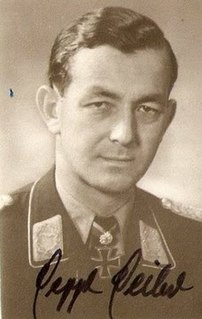
Reinhard Seiler was a Spanish Civil War and World War II Luftwaffe Major and ace, commander of Jagdgeschwader 104 and a winner of the Knight's Cross of the Iron Cross with Oak Leaves of Nazi Germany; for the fighter pilots, it was a quantifiable measure of skill and combat success. Reinhard Seiler was credited with 100 victories during World War II, over the course of about 500 combat missions. He recorded an additional 9 victories during the Spanish Civil War.

Hermann Hogeback was a German bomber pilot during the Nazi era. He flew more than 100 operational sorties during the Spanish Civil War and 500 during World War II and was a recipient of the Knight's Cross of the Iron Cross with Oak Leaves and Swords of Nazi Germany. Hogeback's last service position was commander of the 6th Bomber Wing.
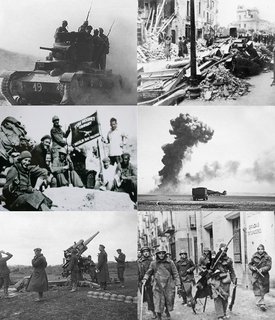
The Spanish Civil War was a civil war in Spain fought from 1936 to 1939. Republicans loyal to the left-leaning Popular Front government of the Second Spanish Republic, in alliance with anarchists, of the communist and syndicalist variety, fought against a revolt by the Nationalists, an alliance of Falangists, monarchists, conservatives and traditionalists, led by a military group among whom General Francisco Franco soon achieved a preponderant role. Due to the international political climate at the time, the war had many facets and was variously viewed as class struggle, a war of religion, a struggle between dictatorship and republican democracy, between revolution and counterrevolution, and between fascism and communism. According to Claude Bowers, U.S. ambassador to Spain during the war, it was the "dress rehearsal" for World War II. The Nationalists won the war, which ended in early 1939, and ruled Spain until Franco's death in November 1975.
Joachim Ziegler was a high-ranking commander in the Waffen-SS of Nazi Germany during World War II. He was a commander of the SS Division Nordland, and was a recipient of the Knight's Cross of the Iron Cross with Oak Leaves.
Joachim Schlichting was a German aviator in the Luftwaffe during the Spanish Civil War and World War II. He was a recipient of the Knight's Cross of the Iron Cross of Nazi Germany.
Rolf Kaldrack was a Luftwaffe fighter ace and recipient of the Knight's Cross of the Iron Cross with Oak Leaves during World War II. A flying ace or fighter ace is a military aviator credited with shooting down five or more enemy aircraft during aerial combat. Kaldrack is credited with at least 24 aerial victories, 3 of which claimed during the Spanish Civil War flying with Aufklärungsgruppe 88 of the Condor Legion.
Rolf Pingel was a German Luftwaffe military aviator and fighter ace during Spanish Civil War and World War II. He is credited with six aerial victories during the Spanish Civil War and further 22 aerial victories on the Western Front of World War II. He flew about 550 combat missions, including approximately 200 in Spain.
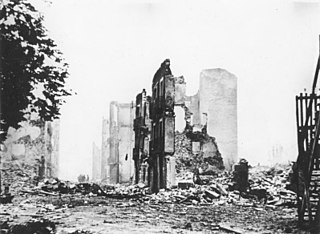
German involvement in the Spanish Civil War commenced with the outbreak of war in July 1936, with Adolf Hitler immediately sending in powerful air and armored units to assist General Francisco Franco and his Nationalist forces. The Soviet Union sent in smaller forces to assist the Republican government, while Britain and France and two dozen other countries set up an embargo on any munitions or soldiers into Spain. Nazi Germany also signed the embargo but simply ignored it.

The Asturias Offensive was an offensive in Asturias during the Spanish Civil War which lasted from 1 September to 21 October 1937. 45,000 men of the Spanish Republican Army met 90,000 men of the Nationalist forces.

The Bombing of Durango took place on 31 March 1937, during the Spanish Civil War. On 31 March 1937 the Nationalists started their offensive against the Republican held province of Biscay. As part of the offensive the Aviazione Legionaria and the Legion Condor bombed Durango, a town of 10,000 inhabitants that was also a key road and railway junction behind the frontline. Around 250 people are believed to have died in the bombing.
he 1939 Madrid Victory Parade was held in Madrid on May 19th, 48 days after the victory of the Nationalists in the Spanish Civil War (1936-1939). It was the first of a yearly series held fom then on in April the First, named Día de la Victoria.






